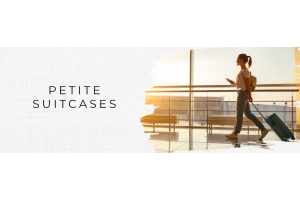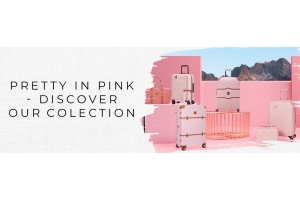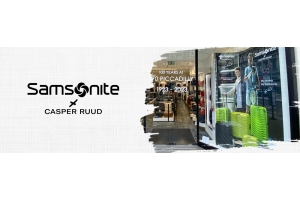10% Off Your First Order*
Est. 1923 – 100 Years Selling the World’s Finest Luggage
Call an expert: 0345 0038283

Tips for first-time flyers
Whether you’re travelling by plane for the first time, or you’re returning to flying after a long break, the process can be daunting. Flying seems so intuitive to some people that you might feel silly asking your jet-setter friends some basic questions about your trip.
To make sure you can approach your upcoming trip with excitement and optimism, we’re sharing our top tips for first-time flyers so you can sit back, relax and enjoy your travels.
Plan ahead
If you want to avoid last-minute stress at the airport, you should plan ahead and make sure you have everything you need. Make sure your passport is up to date and make sure you check in before the flight and download or print your boarding cards. The most important document is your passport and you won't be able to buy the flight without this. if you're travelling internationally you'll need to have at least 6 months of validity on your passport.
You should also make sure you have travel insurance before you leave. print out your documents and bring them with you and make sure you have details for any emergency numbers you might need.
Many Airlines issue e-tickets which can be added to your tablet or smartphone. If you booked online and were expecting to receive your tickets by post, don't panic. Airlines don’t issue paper tickets anymore, so you’ll have to search your confirmation email for more details about how to download your ticket.
Check-in before you get to the airport. This will allow you to select your seat and head straight for security at the airport if you only have hand luggage.
Check your luggage
When travelling by plane, you have a choice between carry-on luggage and check-in luggage. As a newcomer to flying, you might find this a little bit confusing. Every airline has different rules about what is allowed in terms of the size and weight of your luggage.
Usually, if you're travelling a long distance you will be able to check in at least one piece of hold luggage which you will leave at the check-in desk before heading through security.
This luggage will be tagged with the destination and your name and then placed into the hold of the plane. On the other side, you will need to wait by the luggage carousel to collect your suitcase. Since many suitcases look alike, it's a good idea to find a way to make yours stand out. For example, you could add a ribbon to the handle or add a distinct sticker to a hard-shell suitcase.
On short-haul flights, most Airlines will allow you to take a small bag or case that will carry just enough for a long weekend away. There are specific rules about what you can take in a cabin case. This includes restrictions on liquids and electronic devices.
If you're travelling with cabin luggage, you will need to pass through security with your case and allow them to scan the contents. You will be asked to place all liquids in a clear plastic bag and none of these liquids can measure more than 100 ml.
Boarding your flight
Once you have passed through security., you will be in the airport lounge where you can find screens that will tell you where your flight is boarding. Keep a close eye on the screens as this information can change and you might find yourself running to the other end of the airport to board your flight.
In the airport lounge, you will find a range of restaurants and bars alongside duty-free shops. It’s a good idea to buy a bottle of water for your flight and relax with a hot drink and a snack if you have time before your flight.
When it is time to board your flight, you will see an announcement on the board telling you to go to your gate. Signs around the airport will guide you to your gate. If you have limited mobility you can request support from the airport staff. This could include a wheelchair to take you to your gate or you may be escorted on an airport buggy.
This type of service isn't limited to the elderly and disabled, you can also request this if you have limited mobility for example if you recently had surgery and struggle to walk.
On the plane
Once you have found the correct gate, you can now board the aircraft after showing your boarding pass and passport to the airport staff. Your boarding card should include your seat number. You might board the plane through an air tunnel which will take you directly on board the aircraft or you may be placed on a shuttle bus which will drive you to the plane and then you can climb the steps on the front or rear of the plane.
Find your seat and then place your luggage in the overhead Locker. If you have a smaller back this may fit under the seat in front of you which will make some of your leg room so it's a good idea to try to put cases in the overhead lockers where possible.
Some seats on the plane have special rules about where you can place your suitcases, for example, if you are seated at an emergency exit you may not be able to place any items under the seat in front of you. However, you will enjoy slightly more legroom, which can make your flight more comfortable.
Preparing for takeoff
Before the plane takes off the air stewards will give you a demonstration of the safety features on board the aircraft. This isn't something to be afraid of, but you should pay attention so that you know what to do in the event of an emergency.
At this stage, you should also buckle your seatbelt and keep this on for as long as you are seated. You can take it off once the fasten seatbelts signs are turned off, but it’s a good idea to keep it on in case of unexpected turbulence.
At this stage in the flight, you might be feeling a little bit nervous, but don't worry this is completely normal and many first-time flyers experience some jitters before their first take off. You should be prepared for the sensation of accelerating quickly, which feels like someone pushing you into the back of your seat followed by the feeling of the aircraft leaving the ground which can push you down into your seat as the plane climbs.
You might experience some turbulence if you pass through clouds, but this is completely normal and to be expected. Once you have reached altitude the fasten seatbelt signs will be switched off and you will be free to move around the cabin. This includes going to the toilet and retrieving items from your bag, which may be in the overhead Locker.
In-flight etiquette
During the flight, you may be offered food and drink. If the food is included in your flight you will be asked for your preferences in advance. On short-haul flights, food may be offered but you will have to pay extra for it. Don't worry if you don't have any cash with you as many airlines now accept card payments.
If you are sitting next to someone you don't know, it's a good idea to go to the bathroom before the meal is served so they can eat their meal in peace. You should also be wary about reclining your seat during the meal service, as this will affect the tray table of the person sitting behind you.
If you are on a long-haul flight, the cabin lights may be switched off during the night time to allow everyone to rest. You will have a small spotlight above you that you can switch on and off. It’s also common for the person with the window seat to lower the blind so that the lights on the wing don’t illuminate the cabin.
What to do if you are nervous
If you're nervous about flying the best thing to do is speak to the air steward who will be able to help you to get over your fear of flying. They can explain the sounds you hear and the different bumps and movements you might experience.
They can also give you additional support and check-in during periods of turbulence, as this is often the most nerve-wracking time. It’s best to avoid alcohol if you have a fear of flying, as this can heighten your emotions and make it more difficult to stay calm. Instead, try deep breathing techniques to help you remain calm.
Many airlines also offer fear of flying courses, so if you want to take control of your fear of flying, this can be a great place to start. Understanding what is going on during the flight is the best way to take control of your fear once and for all. Once you understand what every little sound and movement means, you’ll be much less likely to be fearful.





